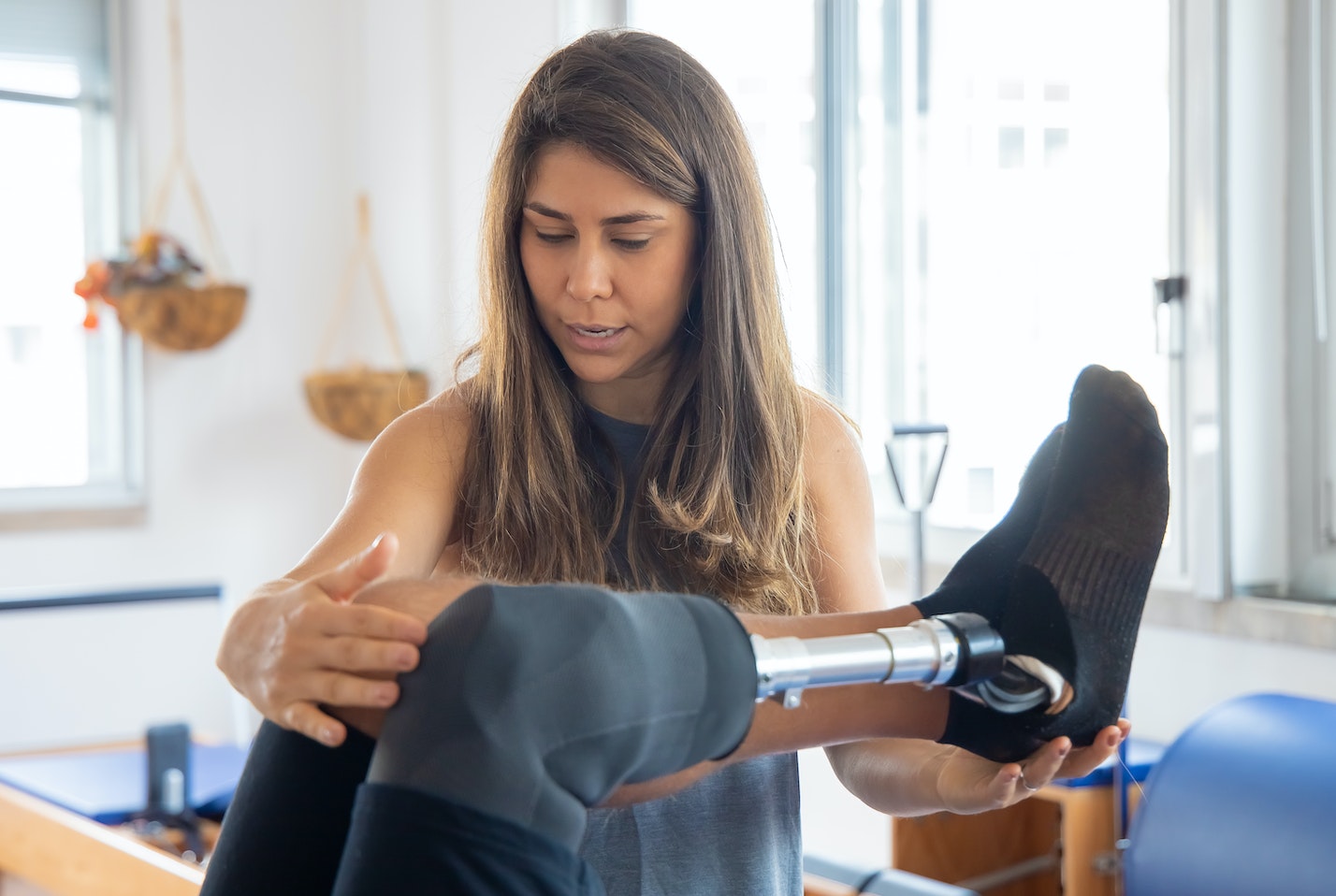A prosthetic leg can be used when a patient has had part or all of a leg amputated, often due to diabetes or an injury. Prosthetic legs can be used for patients who have had their leg amputated due to injury or diabetes. Prosthetic legs range from basic devices that allow a patient to walk on a flat surface to computerized legs that allow patients to run or engage in extreme sports. There are many types of prosthetic legs available. They can be basic, which allow the patient to walk on a smooth surface, or they can be computerized that allow the patient to run and engage in extreme sports.
Typical costs: The average cost:
* For patients with health insurance, out-of-pocket costs typically consist of doctor visit copays and coinsurance of 10%-50%. Patients with health insurance will typically have out-of-pocket expenses that include doctor visits copays and coinsurance between 10% and 50%. All types of prosthetic legs typically are covered by health insurance, but the particular leg that will be covered usually depends on the individual patient’s amputation level, condition and needs. Most prosthetic legs are covered by insurance. However, the specific leg that is covered will depend on the patient’s amputation level and condition. For example, The BlueCross BlueShield of North Carolina policy for lower-limb prostheses states that myoelectric, or computer-controlled, prosthetic legs would be covered for patients who have the physical strength and demonstrated need to move for long distances at variable rates of speed or over uneven terrain. BlueCross BlueShield of North Carolina’s policy for lower-limb prostheses states, for example, that patients with the physical strength and demonstrated ability to move long distances at different speeds or on uneven terrain, myoelectric prosthetic legs (or computer-controlled) would be covered. A basic prosthetic leg might be covered for a homebound individual who needs to move around the house. For homebound individuals who need to move around the house, a basic prosthetic leg may be covered.
* For patients without health insurance, a prosthetic leg typically costs less than $10,000 for a basic prosthetic leg up to $70,000 or more for a more advanced computerized prosthetic leg controlled by muscle movements. A prosthetic leg is usually less expensive than $10,000 for a basic leg, and $70,000 for a computerized leg that can be controlled by muscle movements. Costs depend on the type of leg and the level of amputation. Prices vary depending on the type and extent of the amputation.
* For example, according to a white paper from the Bioengineering Institute Center for Neuroprosthetics, at the Worcester Polytechnic Institute, a basic below-the-knee prosthetic that would allow a patient to walk on flat ground costs $5,000-$7,000, while one that would allow the patient to walk on stairs and bumpy ground could cost $10,000. According to the 2 white paper of the Worcester Polytechnic Institute’s Bioengineering Institute Centre for Neuroprosthetics, a basic prosthetic below the knee that allows a patient to walk flat on ground would cost $5,000 to $7,000.while one that allows the patient to climb stairs or walk on bumpy ground would be $10,000. For a device that would allow a patient to walk and run as well as a non-amputee, the cost could go up to $15,000. The $15,000 cost of a device that allows a patient to run and walk as well as an amputee could be high. Prosthetics with special hydraulic or mechanical systems that allow for movement control can cost more than $15,000. Special hydraulic or mechanical systems for controlling movement can be more expensive than $15,000. And a computer-assisted prosthetic leg costs $20,000 or more. A computer-assisted prosthetic leg can cost $20,000 or more. According to Brown University, the C-Leg computerized prosthetic leg by Otto-Bock, for above-the-knee amputees, can cost as much as $50,000, or up to $70,000 or more, including the prosthetic foot. The C-Leg computerized prosthetic leg by Ottobock for above-the knee amputees can be as high as $50,000. or as high as $70,000, depending on the foot.
* A prosthetic leg likely will need to be replaced several times during a patient’s lifetime, and patients need ongoing adjustments. Prosthetic legs will likely need to be replaced multiple times over a patient’s life. Patients also require ongoing adjustments. A Department of Veterans Affairs study showed the average lifetime cost for prosthetics and medical care for loss of a single leg for a veteran of the Iraq or Afghanistan wars was more than $1.4 million. A Department of Veterans Affairs study found that the average cost of prosthetics and medical treatment for the loss of one leg in the lifetime of a veteran of the Iraq/Afghan wars was greater than $1.4million.
What should be included?
* A few weeks or months after amputation surgery, the patient meets with a prosthetist, a health professional who specializes in evaluating and fitting patients with prostheses. After amputation surgery, the patient sees a prosthetist. This is a professional who specialises in fitting prostheses to patients. The prosthetist takes measurements of the patient and creates a cast of the stump so a temporary prosthesis can be created, to be used for a year or longer while the stump heals and changes shape and size due to muscle atrophy. A prosthetist measures the patient and makes a cast of it. This allows for temporary prostheses to be made. The prostheses can be worn for up to a year while the stump heals or changes in size and shape due to muscle atrophy.
* When the stump has stabilizes, the patient will meet with the prosthetist again to get details about the different types of permanent prosthetic limbs available. Once the stump is stable, the patient will again meet with the prosthetist to discuss the various types of permanent prosthetic legs available. The prosthetist will take another cast of the stump, and the permanent prosthetic leg will be created. Once the stump is stabilized, the prosthetist will make another cast and create the permanent prosthetic leg.
* After testing the prosthetic leg both in the prosthetist’s office and during daily activities, the patient will return for a final fitting. The patient will be able to test the prosthetic leg in the office as well as during daily activities and then return for the final fitting. If desired, a cosmetic cover can be created in the style chosen by the patient. A cosmetic cover can be made in the patient’s choice of style. The Amputee Coalition offers an overview of prosthetic knee types and technology, including pneumatic or hydraulic knees and more advanced knees controlled by microprocessors. The Amputee Coalition provides a comprehensive overview of prosthetic knee technology which includes hydraulic or pneumatic knees as well as advanced microprocessor-controlled knees.
* LimbSpecialists.com offers a step-by-step guide[6 (https://health.costhelper.com/prosthetic-legs.html#extres6) ] to the process of getting a prosthetic leg. LimbSpecialists.com provides a step-by-step guide for the process of getting prosthetic legs.
Additional costs:
* Physical therapy and occupational therapy, which helps patients learn how to perform daily tasks at home or work, will be required. Occupational therapy and physical therapy are required to help patients with daily tasks at work or home. Physical therapy (https://health.costhelper.com/physical-therapist.html) typically costs $50-$350 per session, and occupational therapy (https://health.costhelper.com/occupational-therapy.html) can cost $50-$400 per session. Physical therapy (https://health.costhelper.com/physical-therapist.html) usually costs $50 to$350 per session, while occupational therapy (https://health.costhelper.com/occupational-therapy.html) may cost 50-$400 per session. Total costs for therapy can reach tens of thousands of dollars. Therapy can cost thousands of dollars. The Amputee Coalition offers a guide to physical and occupational therapy. The Amputee Coalition provides a guide for physical and occupational therapy
Discounts:
* Various non-profit organizations provide financial help or free prosthetic limbs for patients in need. Many non-profit organizations offer financial assistance or free prosthetic legs to patients who are in greatest need. The Amputee Coalition offers a list of financial resources and non-profits. The Amputee Coalition provides a list of non-profits and financial resources.
Prosthetic leg shopping:
* OandPCare.org offers a prosthetist locator. OandPCare.org provides a locator for prosthetists. A patient should be evaluated and fitted for a prosthetic leg by a prosthetist who is certified by the American Board for Certification in Orthotics, Prosthetics and Pedorthics or the Board for Orthotist/Prosthetist Certification.
.
* The Amputee Coalition offers tips on choosing a prosthetist.
* MedScape.com provides a guide to choosing a prosthetic leg.
Material on this page is for informational purposes only and should not be construed as medical advice. This page contains information only. It should not be taken as medical advice. Always consult your physician or pharmacist regarding medications or medical procedures. Concerning medications and medical procedures, consult your doctor or pharmacist.



